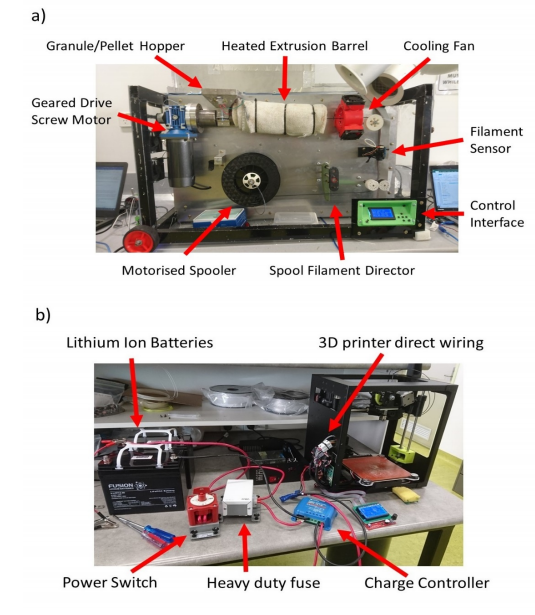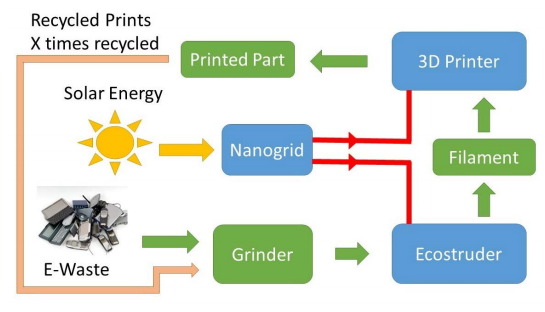Electronic devices are a part of daily life for people across the world – laptops, smart phones, tablets, fitness bands, etc. They’re wonderful to have for many reasons, but none of these devices last forever, and when they’re discarded, they can do serious harm to the environment. Recycling programs are springing up that can refurbish and reuse some of the electronics in the devices, but what about all the plastic that left over? In a paper entitled “The Recycling of E-Waste ABS plastics by melt extrusion and 3D printing using solar powered devices as a transformative tool for humanitarian aid,” a group of researchers discusses how they took ABS plastics found in electronic waste and recycled them using 3D printing.
The researchers used waste plastics from discarded electronic devices within Deakin University‘s School of Engineering. These plastics included the outer casing from devices such as old computers, laptop docking stations and desktop telephones. They cleaned the plastic if needed and then broke it down into fragments and fed it into a hand operated granulation device, which was composed of a series of geared, interlocking teeth that could be rotated using a lever arm. The plastic underwent several phases of repeated grinding, after which it was put through a mesh sieve.
 The researchers then created their own melt extrusion device, which they named the Ecostruder. The system uses a single screw system and is powered by an internally geared DC motor.
The researchers then created their own melt extrusion device, which they named the Ecostruder. The system uses a single screw system and is powered by an internally geared DC motor.
“To ensure that the screw operates at a constant RPM, an encoder is used to measure the rotational velocity, and which is feedback into a PID controller,” the researchers explain. “The screw is also coupled directly to the geared motor, which provides a simple and robust interface where auxiliary chains are not required. Three individually controlled 50W band heaters provide the ability vary the temperature distribution along the barrel, which in turn allows for control of how the fed waste plastic transitions from solid to the liquid phases.”
Once the filament was generated by the Ecostruder, it was 3D printed using a LulzBot Mini. To make the entire process even more eco-friendly, the researchers used a nanogrid system powered by solar energy, via portable photovoltaic (PV) panels.
“In an ideal scenario, the system which we aimed to create would have the capacity to operate solely from the use of the energy generated by the PV’s,” the researchers state. “This would not be realistic in real operational scenarios and so the aim was to create a dynamic system that could operate directly utilising the energy from the PV cells, and divert excess charge to the lithium-ion batteries. Conversely, in times when insufficient electricity is generated to power a respective device, charge from the battery system can be utilised to sustain operations.”
Tests were performed on the nanogrid system to evaluate its charge generation efficiency. Test 1 was performed on a cloudy day, and Test 2 on a sunny day. The average sustained power output was approximately 14W for test 1 and 210W for test 2. Future modifications of the system may include building larger banks of batteries to store excess charge during times of peak generation, for use on days when power generation is suboptimal.
To test the 3D printing performance of the system, the researchers took it to a location with clear exposure to the sun and 3D printed three different parts: a 20x20x20mm cube, a 30mm diameter and 30mm height cylinder and a lattice structure with a cube of 30x30x30mm. The test was completed in approximately 90 minutes, and the solar panels not only adequately powered the 3D printer but held an excess of energy.
“If we assume the same environmental conditions over a typical day of operation, which would comprise running the 3D printer for 8 hours and the Ecostruder for 2 hours, the generated excess energy would accommodate this usage whilst also charging the battery system by an additional 25Ah,” the researchers state.
 Tests were also performed to evaluate the quality of the 3D printed recycled material. To do this, the researchers 3D printed a pipe connector. There were a few cosmetic surface defects, but the part was robust. The researchers used the printed part to join a section of piping, and tested it by blocking the end of one piece of tubing, pressurizing the system using a plumbing pressure testing device. The part held the water with no leakage up to a pressure of 5Bar. The results show that the recycled ABS can be used to 3D print functional parts.
Tests were also performed to evaluate the quality of the 3D printed recycled material. To do this, the researchers 3D printed a pipe connector. There were a few cosmetic surface defects, but the part was robust. The researchers used the printed part to join a section of piping, and tested it by blocking the end of one piece of tubing, pressurizing the system using a plumbing pressure testing device. The part held the water with no leakage up to a pressure of 5Bar. The results show that the recycled ABS can be used to 3D print functional parts.
Future studies aim to test the system in field conditions to assess its potential for humanitarian aid.
Authors of the paper include Mazher Iqbal Mohammed, Daniel Wilson, Eli Gomez-Kervin, Callum Vidler, Lucas Rosson and Johannes Long.
Discuss this and other 3D printing topics at 3DPrintBoard.com or share your thoughts below.
Subscribe to Our Email Newsletter
Stay up-to-date on all the latest news from the 3D printing industry and receive information and offers from third party vendors.
You May Also Like
NSF Awards Kentucky $1M for Advanced Manufacturing
The National Science Foundation has awarded a $1 million grant to the University of Louisville for the Advancing Manufacturing and Building Construction Technologies (NSF AMT) project. This initiative is part...
3D Printing News Briefs, May 11, 2024: 3D Printed Stent, Tower, Sculptures, & More
We’re starting off with medical research in today’s 3D Printing News Briefs, as researchers in Korea used CT images and 3D printing to fabricate an educational simulator for a mastoidectomy....
3D Printing Unpeeled: Wind Turbines, Probiotics and Lenses
TPI Composites, ORNL and Ingersoll Rand are working to make wind turbine tooling segments that can be 18.3 meters long. These elements also include resistive wires that help keep the...
Tethon 3D Releases Cost-effective Bioprinter
Tethon 3D, known for its ceramic-loaded DLP materials, custom resins, and DLP 3D printers, has recently released a bioprinter. Vat polymerization printers like DLP systems have been widely used by...

































